
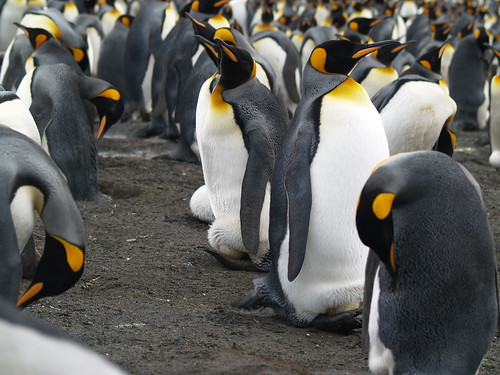

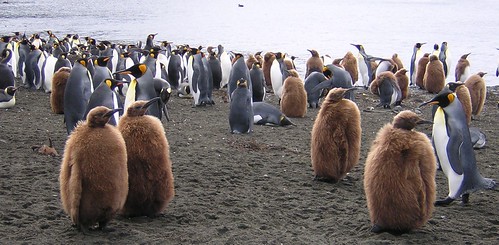
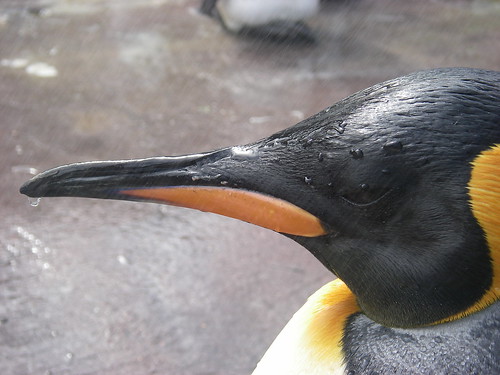
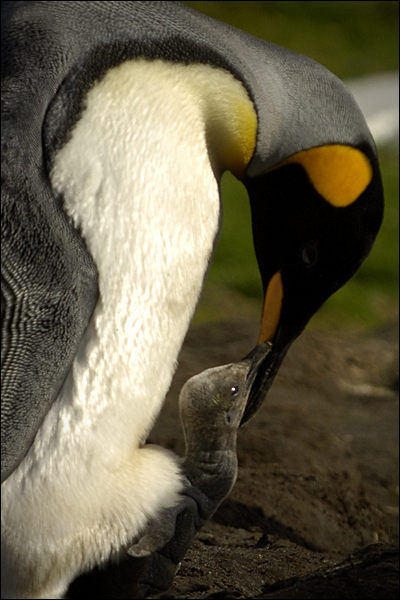
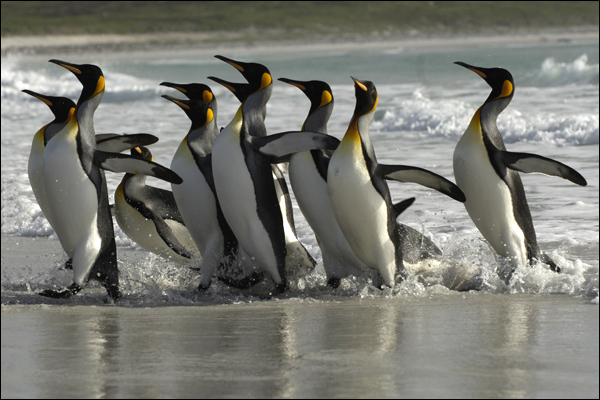
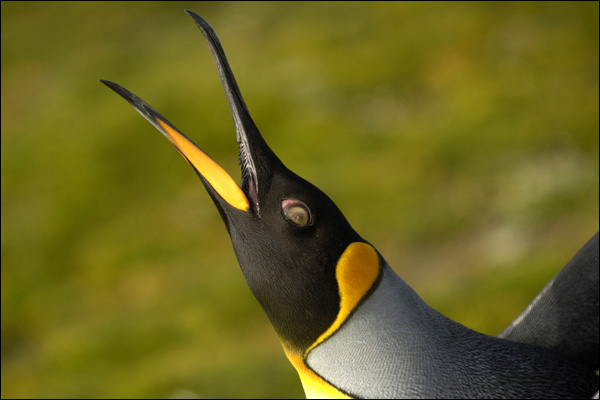
Aptenodytes patagonicus
king penguin
Geographic Range
King penguins are found on island groups in the sub-Antarctic region (the South Atlantic Ocean, Indian Ocean, and southwest Pacific Ocean), including islands south of Australia, Tasmania, New Zealand, and South Africa. The limit of the breeding range is around 45 degrees south latitude to the Antarctic Convergence. Aptenodytes patagonicus do not migrate, instead individuals travel hundreds of kilometers away from breeding grounds to find food. (Carroll, 2006; Marion, 1999)
Biogeographic Regions:
atlantic ocean (native ); pacific ocean (native ).
Other Geographic Terms:
island endemic .
Habitat
Elevation
Depth
10 to 200 m
(32.8 to 656 ft)
King penguins establish breeding colonies on temperate-cool islands with low, bare ground (including beaches, valleys, and glacial moraines). These penguins are both terrestrial and aquatic: terrestrial while breeding in colonies and aquatic for purposes of finding food. In these colonies, the temperature is near to or below 10 degrees Celsius. Rarely are king penguins found on ice or snow covered grounds. They prefer to be close to the sea, allowing for a convenient food source. ("King Penguins - Wildlife of Antarctica - Antactic Connection", 1998; Busch Entertainment Corporation, 2002; Carroll, 2006; Sparks and Soper, 1987)
These animals are found in the following types of habitat:
temperate; polar; terrestrial; saltwater or marine .
Aquatic Biomes:
coastal.
Physical Description
Mass
11000 to 15000 g; avg. 13000 g
(387.2 to 528 oz; avg. 457.6 oz)
Length
85 to 95 cm
(33.46 to 37.4 in)
Basal Metabolic Rate
Aptenodytes patagonicus is closely related to Aptenodytes forsteri, emperor penguins. Adult king penguins are smaller than emperor penguins, measuring between 85 and 95 cm tall. Males are generally taller than females, otherwise they are monomorphic. They weight from 11 to 15 kg. King penguins have a rounded body, silvery-grey back, and a dark (blackish-brown) head. They are known for their bright-orange ear patch and for the bright-pink patch on the mandible, which is larger than that of emperor penguins. They use their white and black flippers, or wings, for swimming and their black feet for walking on land, as they cannot fly. Aptenodytes patagonicus is more slender in the body and has a longer bill than emperor penguins. Their dense plumage protects them from bitter, sub-Antarctic weather and consists of four layers: the outer layer is oily and waterproof and encloses three downy layers for insulation. ("King Penguin", 2006; "King Penguins - Wildlife of Antarctica - Antactic Connection", 1998; Marion, 1999)
Some key physical features:
endothermic ; homoiothermic; bilateral symmetry .
Sexual dimorphism: sexes alike.
Reproduction
Breeding interval
King penguins breed two times every 3 years, during the winter.
Breeding season
The breeding season for king penguins takes place during the winter. Eggs can be laid anytime from November through April.
Eggs per season
1 (average)
Time to hatching
8 weeks (average)
Time to fledging
9 months (average)
Time to independence
12 to 14 months
Age at sexual or reproductive maturity (female)
4 to 5 years
Age at sexual or reproductive maturity (male)
4 to 5 years
On arrival at a rookery, Aptenodytes patagonicus individuals use a variety of ways to attract a mate. Males will open their flippers and emit a call while stretching its head up, throwing the head back, and finally bowing. A female then chooses the male she wants to mate with by answering his call. King penguins are monogamous within the breeding season and are likely to breed with the same mate over successive breeding seasons unless one of the pair dies. (Carroll, 2006; Marion, 1999)
Mating systems:
monogamous .
King penguins have a long breeding season (14 to 16 months), compared to other penguin species. They breed twice every three years. Each time they breed they lay one egg. The breeding season for king penguins takes place during the winter. Eggs are laid anytime from November through April. The incubation period is around 54 days. It takes about 9 months for the chick to be fully fledged and up to 14 months to become independent. ("King Penguins - Wildlife of Antarctica - Antactic Connection", 1998; Carroll, 2006; Sparks and Soper, 1987; Woehler, 2001)
Key reproductive features:
iteroparous ; seasonal breeding ; gonochoric/gonochoristic/dioecious (sexes separate); sexual ; oviparous .
When the female king penguin lays her egg, she delicately passes it to her mate. The male incubates the egg for about 19 days, while the female is foraging at sea. When the female returns, the parents take turns incubating the egg until hatching, with each parent spending two to three weeks at a time incubating the egg while the other is foraging. Once the chick has hatched, both parents take care of the young. (Marion, 1999)
Penguin chicks are not able to regulate their body temperature when first hatched, they are brooded by both parents alternately. It takes about 3 weeks until the chick can be left alone. The parents take turns caring for the chick 3 to 4 days at a time. Once the chick is able to fend for itself, it joins neighboring chicks in a large group, or creche, for protection. Parents then bring their chick food every 2 to 3 days until the chick is fully fledged, in 43 to 60 weeks. (Marion, 1999)
Parental investment:
altricial ; pre-fertilization (provisioning, protecting: female); pre-hatching/birth (provisioning: female, protecting: male, female); pre-weaning/fledging (provisioning: male, female, protecting: male, female); pre-independence (provisioning: male, female, protecting: male, female).
Lifespan/Longevity
Extreme lifespan (wild)
26 years (high)
Extreme lifespan (captivity)
41 years (high)
Typical lifespan (captivity)
The lifespan of Aptenodytes patagonicus in the wild is not well known. Average lifespan in the wild is estimated at 15 to 20 years. The oldest king penguin in captivity reached 41 years old. ("Levensverwachting of ouderdom", 2005; "The Penguin", 2002; Francois, 2002)
Behavior
King penguins form large groups on seven main islands in sub-Antarctic region. These colonies range in size from 30 to thousands of penguin pairs. Aptenodytes patagonicus is a highly social species and individuals rarely fight. (Carroll, 2006; Woehler, 2001)
Aptenodytes patagonicus moves on land by foot and moves through the water using its wings, more commonly known as flippers. Because of its sleek body frame this penguin walks on land fairly well and does not hop around like emperor penguins. King penguins breed on land and travel great distances from their rookeries to find food. They are well adapted to the sea because of their morphology; they use a lot less energy traveling underwater than on land. (Carroll, 2006; Marion, 1999; Woehler, 2001)
When temperatures get too cold, these penguins increase metabolic heat production through shivering thermogenesis. In extremely cold temperatures these penguins also huddle together in rookeries, protecting both themselves and the young from the cold. (Marion, 1999)
Home Range
The home range for A. patagonicus is not known. However, they will travel hundreds of kilometers to find food.
Key behaviors:
terricolous; diurnal ; motile ; nomadic ; social ; colonial .
Communication and Perception
When king penguins arrive and depart from a breeding colony, they use acoustic and visual signals to communicate to mates. Acoustic signals are courtship calls between mates. Visual signals consist of a series of bows and neck movements. (Carroll, 2006)
Communicates with:
visual; acoustic.
Perception channels:
visual; tactile; acoustic; chemical.
Food Habits
King penguins hunt in groups. They travel hundreds of kilometers to find food. During warm, summer conditions they find food 10 to 200 meters below the ocean surface. In the winter their prey move to deeper waters, requiring king penguins to dive deeper. King penguins fast while on land caring for their young and replenish their reserves through foraging trips. Their diet is composed mostly of fish and cephalopods. (Marion, 1999; Prevost and Gill, 1995)
Primary Diet:
carnivore (piscivore , molluscivore).
Animal Foods:
fish; mollusks; aquatic crustaceans.
Predation
Known predators
* leopard seals (Hydrurga leptonyx)
* killer whales (Orcinus orca)
* skuas (Stercorariidae)
* sheathbills (Chionis)
* giant petrels (Macronectes giganteus)
King penguins are prey for leopard seals and killer whales that wait beneath the surface of the water. Shorebirds, such as skuas, sheathbills, and giant petrels, prey on king penguin eggs and young chicks while these are unattended by adults. ("King Penguins - Wildlife of Antarctica - Antactic Connection", 1998; Sparks and Soper, 1987)
Ecosystem Roles
In marine ecosystems of the southern oceans, king penguins impact populations of fish and crustaceans. (Carroll, 2006)
Economic Importance for Humans: Negative
There are no known adverse effects of Aptenodytes patagonicus on humans. ("King Penguins - Wildlife of Antarctica - Antactic Connection", 1998)
Economic Importance for Humans: Positive
During the 19th and 20th centuries, poachers used king penguin oil, flesh, and eggs for fuel, food, and clothing. Laws against poaching were formed by the International Ornithological Congress in 1905 and by the Antarctic Treaty in 1959. ("King Penguins - Wildlife of Antarctica - Antactic Connection", 1998)
Ways that people benefit from these animals:
food ; body parts are source of valuable material.
Conservation Status
IUCN Red List:
Least Concern.
US Migratory Bird Act:
No special status.
US Federal List:
No special status.
CITES:
No special status.
Aptenodytes patagonicus is a species of least concern according to the IUCN. There are currently two million king penguin breeding pairs. They have been harmed by human-influenced disasters, such as oil spills. ("King Penguins - Wildlife of Antarctica - Antactic Connection", 1998; Woehler, 2001)
Contributors
Tanya Dewey (editor), Animal Diversity Web, University of Michigan Museum of Zoology.
Megan Korc (author), Kalamazoo College. Ann Fraser (editor, instructor), Kalamazoo College.
References
2006. "2006 IUCN Red list of threatened species" (On-line). Accessed October 15, 2006 at http://www.iucnredlist.org/.
2006. "Birds protected by the migratory bird treaty act" (On-line). Accessed October 15, 2006 at http://www.fws.gov/migratorybirds/intrnltr/mbta/mbtintro.html.
2006. "Convention on international trade in endangered species of wild fauna and flora" (On-line). Accessed October 15, 2006 at http://www.cites.org/eng/app/appendices.shtml.
2006. "King Penguin" (On-line). Accessed October 15, 2006 at http://en.wikipedia.org/wiki/King_penguin.
1998. "King Penguins - Wildlife of Antarctica - Antactic Connection" (On-line). Accessed October 15, 2006 at http://www.antarcticaconnection.com/antarctic/wildlife/penguins/king.shtml.
2005. "Levensverwachting of ouderdom" (On-line). Accessed October 15, 2006 at http://www.pinguins.info/FRAMES/Lifespan_nl.html.
2006. "Michigan's special animals" (On-line). Accessed October 15, 2006 at http://web4.msue.msu.edu/mnfi/data/specialanimals.cfm.
2006. "Species information: Threatened and endangered animals and plants" (On-line). Accessed October 15, 2006 at http://www.fws.gov/endangered/wildlife.html.
2002. "The Penguin" (On-line). Creature of the Month. Accessed October 15, 2006 at http://www.no-pest.com/Penguins.htm.
Busch Entertainment Corporation. 2002. "Diet and eating habits" (On-line). Accessed November 15, 2006 at http://www.seaworld.org/infobooks/Penguins/diet.html.
Carroll, P. 2006. "The King Penguin (Aptenodytes patagonica)" (On-line). Accessed October 15, 2006 at http://www.btinternet.com/~sa_sa/birdlife/king_penguin.html.
Francois, J. 2002. "World's oldest captive penguin dies" (On-line). Accessed October 15, 2006 at http://www.icevision.com/news/1013636261/index_html.
Marion, R. 1999. Penguins: A worldwide guide. New York, NY: Sterling Publishing Company, Inc.
Prevost, J., F. Gill. 1995. "Penguin" (On-line). Encyclopedia Britannica Article. Accessed October 15, 2006 at http://0-search.eb.com.ariadne.kzoo.edu/eb/print?articleld=105926&fullArticle=true&tocld=48927.
Sparks, J., T. Soper. 1987. Penguins. New York, NY: Facts On File Publications.
Woehler, E. 2001. "King Penguin: 10 Facts" (On-line). Accessed October 15, 2006 at http://courseweb.tac.unt.edu/overall/CECS4100/Spring2003/Section6/Dunning/KingPenguin_10Facts.htm.
2009/05/31 01:48:13.579 GMT-4
To cite this page: Korc, M. and A. Fraser. 2006. "Aptenodytes patagonicus" (On-line), Animal Diversity Web. Accessed June 05, 2009 at http://animaldiversity.ummz.umich.edu/site/accounts/information/Aptenodytes_patagonicus.html.

















1 comment:
Post a Comment